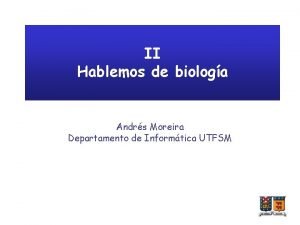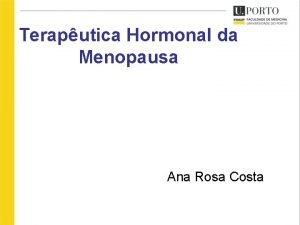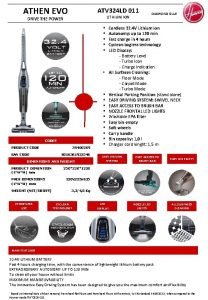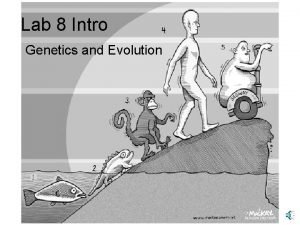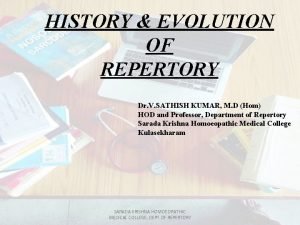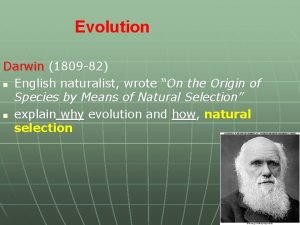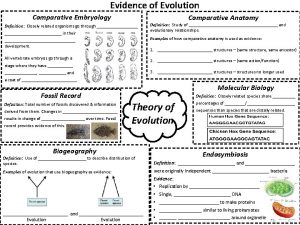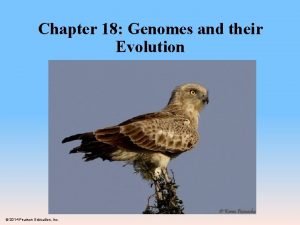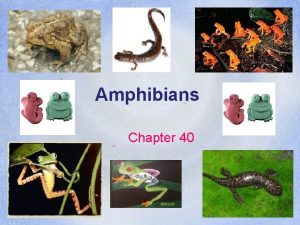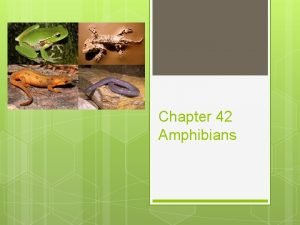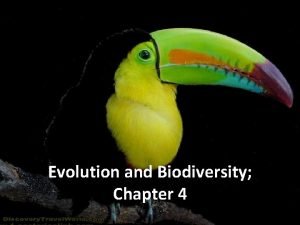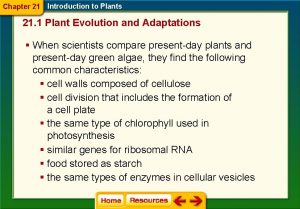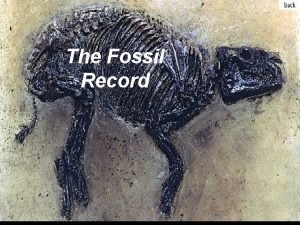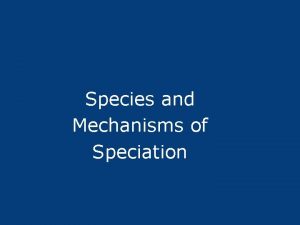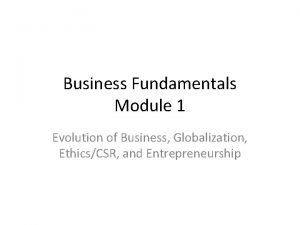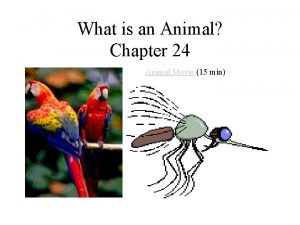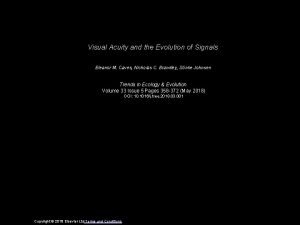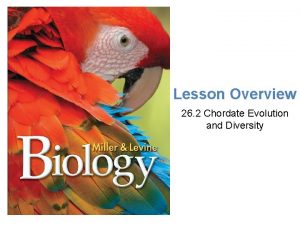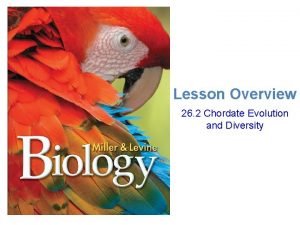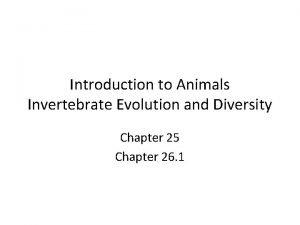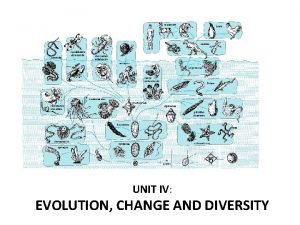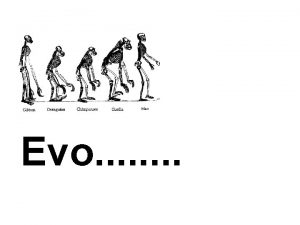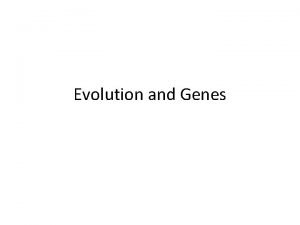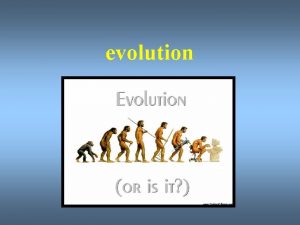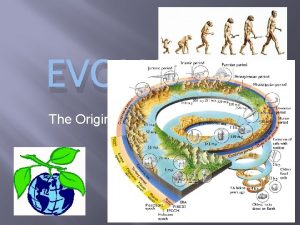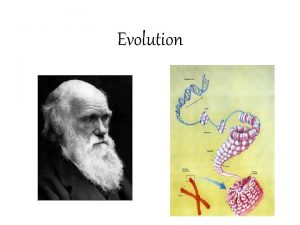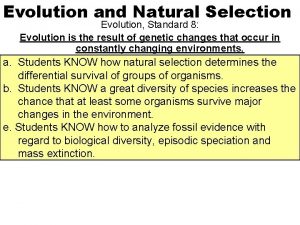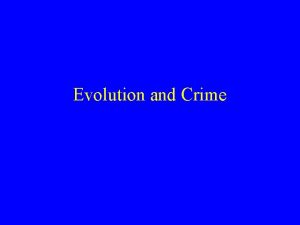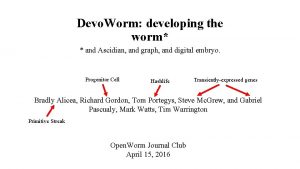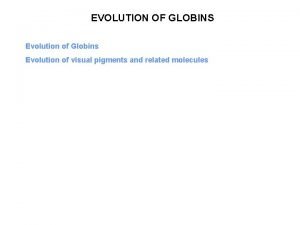Evo Devo Evo Devo Evolution and Development I









































































- Slides: 73


Evo. . . . Devo

Evo - Devo: Evolution and Development I. Background

Evo - Devo I. Background - Embrologists have long realized that organisms in different phyla have different developmental "plans"

Evo - Devo I. Background - Embrologists have long realized that organisms in different phyla have different developmental "plans" - And in a phylum, there is the same developmental plan. This is not necessarily what we might expect from random mutation and evolution. . . why don't we see as many differences in early developmental traits as we see in later developing traits?

- For instance, why do chordates have similar development, even though cartilaginous fish and other vertebrates are separated by 400 million years of divergent evolution?

Evo - Devo I. Background - Embrologists have long realized that organisms in different phyla have different developmental "plans" - And in a phylum, there is the same developmental plan. This is not necessarily what we might expect from random mutation and evolution. . . why don't we see as many differences in early developmental traits as we see in later developing traits? - For instance, why do chordates have similar development, even though cartilaginous fish and other vertebrates are separated by 400 million years of divergent evolution. - Embryological development is highly conserved, while subsequently allowing extraordinary variation. .

Evo - Devo I. Background II. Core Processes - Basic biological processes are CONSERVED, and the enzymes that perform them are CONSERVED:

Evo - Devo I. Background II. Core Processes - Basic biological processes are CONSERVED, and the enzymes that perform them are CONSERVED: DNA, RNA, protein synthesis - ALL LIFE

Evo - Devo I. Background II. Core Processes - Basic biological processes are CONSERVED, and the enzymes that perform them are CONSERVED: DNA, RNA, protein synthesis - ALL LIFE Membrane structure and function - ALL EUK's

Evo - Devo I. Background II. Core Processes - Basic biological processes are CONSERVED, and the enzymes that perform them are CONSERVED: DNA, RNA, protein synthesis - ALL LIFE Membrane structure and function - ALL EUK's Cell junctions - ALL METAZOA

Evo - Devo I. Background II. Core Processes - Basic biological processes are CONSERVED, and the enzymes that perform them are CONSERVED: DNA, RNA, protein synthesis - ALL LIFE Membrane structure and function - ALL EUK's Cell junctions - ALL METAZOA Hox genes - ALL BILATERIA

Evo - Devo I. Background II. Core Processes - Basic biological processes are CONSERVED, and the enzymes that perform them are CONSERVED: DNA, RNA, protein synthesis - ALL LIFE Membrane structure and function - ALL EUK's Cell junctions - ALL METAZOA Hox genes - ALL BILATERIA Limb formation - ALL LAND VERTEBRATES

Evo - Devo I. Background II. Core Processes - Basic biological processes are CONSERVED, and the enzymes that perform them are CONSERVED: - Many enzymes are more than 50% similar in AA sequence in E. coli and H. sapiens, though separated by 2 billion years of divergence. - Of 548 metabolic enzymes in E. coli, 50% are present in ALL LIFE, and only 13% are unique to bacteria.

Evo - Devo I. Background II. Core Processes - Basic biological processes are CONSERVED, and the enzymes that perform them are CONSERVED: - Many enzymes are more than 50% similar in AA sequence in E. coli and H. sapiens. - Of 548 metabolic enzymes in E. coli, 50% are present in ALL LIFE, and only 13% are unique to bacteria. - So the variation and diversity of life is NOT due to changes in metabolic or structural genes. . . we are all built out of the same stuff, that works the same way at a cellular level.

Evo - Devo I. Background II. Core Processes - Basic biological processes are CONSERVED, and the enzymes that perform them are CONSERVED: - Many enzymes are more than 50% similar in AA sequence in E. coli and H. sapiens. - Of 548 metabolic enzymes in E. coli, 50% are present in ALL LIFE, and only 13% are unique to bacteria. - So the variation and diversity of life is NOT due to changes in metabolic or structural genes. . . we are all built out of the same stuff, that works the same way at a cellular level. - Variation is largely due to HOW these processes are REGULATED. . . 300 cell types in humans, all descended from the zygote; all genetically the same.

Evo - Devo I. Background II. Core Processes III. Weak Linkage Regulation - Development is NOT a single process

Evo - Devo I. Background II. Core Processes III. Weak Linkage Regulation - Development is NOT a single process - Development is a well choreographed dance of many parallel processes. . .

Evo - Devo I. Background II. Core Processes III. Weak Linkage Regulation - Development is NOT a single process - Development is a well choreographed dance of many parallel processes. . . - How is the parallelism maintained, ESPECIALLY as one process evolves?

Evo - Devo I. Background II. Core Processes III. Weak Linkage Regulation - Development is NOT a single process - Development is a well choreographed dance of many parallel processes. . . - How is the parallelism maintained, ESPECIALLY as one process evolves? - Because they may be triggered by the same (or subsets of the same) REGULATORS. . . these are transcription factors that can turn suites of metabolic/structural genes on and off.

Evo - Devo I. Background II. Core Processes III. Weak Linkage Regulation - Development is NOT a single process - Development is a well choreographed dance of many parallel processes. . . - How is the parallelism maintained, ESPECIALLY as one process evolves? - Because they may be triggered by the same (or subsets of the same) REGULATORS. . . these are transcription factors that can turn suites of metabolic/structural genes on and off. And transcription factors can interact.

Evo - Devo I. Background II. Core Processes III. Weak Linkage Regulation - Best (and most fundamental) examples are HOX genes. These are 'homeotic genes' that produce a variety of transcription factors. The production and localization of these transcription factors are CRITICAL in determining the 'compartments' of bilaterally symmetrical animals.

Evo - Devo I. Background II. Core Processes III. Weak Linkage Regulation - Duplication of hox genes can lead to differential regulation in different segments, and different phenotypes in different segments. inhibition of limb development

Evo - Devo I. Background II. Core Processes III. Weak Linkage Regulation - Duplication of hox genes can lead to differential regulation in different segments, and different phenotypes in different segments. Each gene produces a DNA binding protein that turns on a set of genes. . . different hox genes produce different binding proteins, that stimulate different sets of genes. . . that are ALL regulated by THIS transcription factor (linked regulation coordinated response).

Evo - Devo I. Background II. Core Processes III. Weak Linkage Regulation - Effects can be profound antennaepedia

Evo - Devo I. Background II. Core Processes III. Weak Linkage Regulation - Effects can be profound - But they demonstrate the 'modularity' of the developmental plan - only single units are affected. Bithorax

Evo - Devo I. Background II. Core Processes III. Weak Linkage Regulation - Effects can be profound - But they demonstrate the 'modularity' of the developmental plan - only single units are affected. - 'Master Switches' that initiate downstream cascades that can be very different. . . like compound or vertebrate eyes.



Evo - Devo I. Background II. Core Processes III. Weak Linkage Regulation - and they are still integrated with the rest of the organism For example, the length of a breed's snout correlated directly with the number of repeats in a gene called Runx-2's tandem repeat consists of two different three-base sequences, randomly ordered along the length of the repeat. If there's more of one threesome relative to the other, that breed's muzzle tends to be longer and straighter. Fonden and Garner. 2004. PNAS

This protein is a member of the RUNX family of transcription factors and has a Runt DNA-binding domain. It is essential for osteoblastic differentiation and skeletal morphogenesis and acts as a scaffold for nucleic acids and regulatory factors involved in skeletal gene expression. The protein can bind DNA both as a monomer or, with more affinity, as a subunit of a heterodimeric complex. Transcript variants of the gene that encode different protein isoforms result from the use of alternate promoters as well as alternate splicing. [1] “One gene of interest may be RUNX 2 (CBFA 1). It is the only gene in the genome known to cause cleidocranial dysplasia, which is characterized by delayed closure of cranial sutures, hypoplastic or aplastic clavicles, a bell-shaped rib cage, and dental abnormalities (70). Some of these features affect morphological traits for which modern humans differ from Neandertals as well as other earlier hominins. For example, the cranial malformations seen in cleidocranial dysplasia include frontal bossing, i. e. , a protruding frontal bone. A more prominent frontal bone is a feature that differs between modern humans and Neandertals as well as other archaic hominins. The clavicle, which is affected in cleidocranial dysplasia, differs in morphology between modern humans and Neandertals (71) and is associated with a different architecture of the shoulder joint. Finally, a bell-shaped rib cage is typical of Neandertals and other archaic hominins. A reasonable hypothesis is thus that an evolutionary change in RUNX 2 was of importance in the origin of modern humans and that this change affected aspects of the morphology of the upper body and cranium. ”



Evo - Devo I. Background II. Core Processes III. Weak Linkage Regulation - Types of Regulation Enhancer - upstream activation sequence. Binding site for transcription factor. Mutation here is cis-regulation (within the operational "cistron")

Evo - Devo I. Background II. Core Processes mutation in the transcription factor gene is called trans-regulation III. Weak Linkage Regulation - Types of Regulation Enhancer - upstream activation sequence. Binding site for transcription factor. Mutation here is cis-regulation (within the operational "cistron")

Evo - Devo I. Background II. Core Processes mutation in the transcription factor gene is called trans-regulation III. Weak Linkage Regulation - Types of Regulation Enhancer - upstream activation sequence. Binding site for transcription factor. Mutation here is cis-regulation (within the operational "cistron") Each type modulates activity about 50% of the time. . .

Evo - Devo I. Background II. Core Processes III. Weak Linkage Regulation - NOVELTY Mutations may make an enhancer available to a different transcription factor. . . and now that gene is 'on' in a new tissue and can be used for a new function. Crystallins are heat-shock proteins and mitochondrial enzymes; but when they are expressed in the eye, they are used as transparent structural proteins in a completely different process.

And of course, how they are arranged in lenses vary.

Evo - Devo I. Background II. Core Processes III. Weak Linkage Regulation - NOVELTY OR, an entirely new binding site can evolve - they are typically quite short (6 -10 bases) so they will arise frequently by random mutation. . . selection can then favor new regulatory pathways. . KEEP THE OLD, but GAIN NEW (sound familiar? ? ? )

- Prud'homme et al. 2006. Repeated morphological evolution through cisregulatory changes in a pleiotropic gene Nature 440: 1050 -1053. a–c, The wing spots on male flies of the Drosophila genus. Drosophila tristis (a) and D. elegans (b) have wing spots that have arisen during convergent evolution. Drosophila gunungcola (c) instead evolved from a spotted ancestor. d, Males wave their wings to display the spots during elaborate courtship dances. (Photographs courtesy of B. Prud'homme and S. Carroll. )

- Prud'homme et al. 2006. Repeated morphological evolution through cisregulatory changes in a pleiotropic gene Nature 440: 1050 -1053. yellow gene enzyme for pigment production "spotted wing" In their previous research, they found that spotted members of both spotted clades had same cis regulatory element (CRE). So, they hypothesized that all members of the clade were descended from a spotted ancestor (99% chancestor was spotted - fig. )

- Prud'homme et al. 2006. Repeated morphological evolution through cisregulatory changes in a pleiotropic gene Nature 440: 1050 -1053. yellow gene LOSS of the spot within this clade (an example of convergent evolution AND reversion) occurred by different mutations in same CRE.

- Prud'homme et al. 2006. Repeated morphological evolution through cisregulatory changes in a pleiotropic gene Nature 440: 1050 -1053. yellow gene LOSS of the spot within this clade (an example of convergent evolution AND reversion) occurred by different mutations in same CRE. Importantly, yellow is still on elsewhere. This is a pleiotropic gene that has many effects.

- Prud'homme et al. 2006. Repeated morphological evolution through cisregulatory changes in a pleiotropic gene Nature 440: 1050 -1053. yellow gene LOSS of the spot within this clade (an example of convergent evolution AND reversion) occurred by different mutations in same CRE. Importantly, yellow is still on elsewhere. This is a pleiotropic gene that has many effects. Shutting it "off" by a mutation in the gene would cripple it's activity throughout the organism. Here, through cis regulation, it's expression is modulated in only one tissue (wing).

- Prud'homme et al. 2006. Repeated morphological evolution through cisregulatory changes in a pleiotropic gene Nature 440: 1050 -1053. yellow gene spotted wing In D. tristis, the yellow gene is enhanced by a completely different, independently evolved CRE.

- Prud'homme et al. 2006. Repeated morphological evolution through cisregulatory changes in a pleiotropic gene Nature 440: 1050 -1053. Two gains and two losses are due to independent changes in the regulation of the yellow gene. The developmental 'scaffold' forming spots exists. . . subsequent evolution of enhancement can form a new anatomical trait, which can be rapidly selected for by sexual selection.

Evo - Devo I. Background II. Core Processes III. Weak Linkage Regulation - HETEROCHRONY - paedomorphism - peramorphism - allometry All simply changes in the developmental rates of different structures or processes.

Allometry in horn length relative to body size in Beetles Scarabaeidae: Onthophagus

Evolution of legs from fins

Evolution of legs from fins

Evo - Devo I. Background II. Core Processes III. Weak Linkage Regulation IV. Exploratory Behavior

Evo - Devo I. Background II. Core Processes III. Weak Linkage Regulation IV. Exploratory Behavior - environmental cues affect cell activity - production of growth factors

Evo - Devo I. Background II. Core Processes III. Weak Linkage Regulation IV. Exploratory Behavior - environmental cues affect cell activity - production of growth factors - hypoxia - stimulates cell to produce endothelial growth factor

Evo - Devo I. Background II. Core Processes III. Weak Linkage Regulation IV. Exploratory Behavior - environmental cues affect cell activity - production of growth factors - hypoxia - stimulates cell to produce endothelial growth factor - neighboring vascular tissue grows towards the source of growth factor

Evo - Devo I. Background II. Core Processes III. Weak Linkage Regulation IV. Exploratory Behavior - environmental cues affect cell activity - production of growth factors - hypoxia - stimulates cell to produce endothelial growth factor - neighboring vascular tissue grows towards the source of growth factor - and BINGO. . . now you have vascular tissue and hypoxia is corrected

Evo - Devo I. Background II. Core Processes III. Weak Linkage Regulation IV. Exploratory Behavior - environmental cues affect cell activity - production of growth factors - hypoxia - stimulates cell to produce endothelial growth factor - neighboring vascular tissue grows towards the source of growth factor - and BINGO. . . now you have vascular tissue and hypoxia is corrected - Nerves and vessels grow in response to local signals. . . the pattern is not hardwired.

Evo - Devo I. Background II. Core Processes III. Weak Linkage Regulation IV. Exploratory Behavior - environmental cues affect cell activity - production of growth factors - hypoxia - stimulates cell to produce endothelial growth factor - neighboring vascular tissue grows towards the source of growth factor - and BINGO. . . now you have vascular tissue and hypoxia is corrected - Nerves and vessels grow in response to local signals. . . the pattern is not hardwired. - So, if bone growth changes, muscles cell growth responds, and correct ennervation and vascularization occurs on this new platform.

Evo - Devo I. Background II. Core Processes III. Weak Linkage Regulation IV. Exploratory Behavior V. Physiology and Evolution

Evo - Devo stress response phenotype I. Background II. Core Processes III. Weak Linkage Regulation IV. Exploratory Behavior V. Physiology and Evolution - stress can reveal new phenotypes - "norm of reaction"

Evo - Devo stress response phenotype I. Background II. Core Processes III. Weak Linkage Regulation IV. Exploratory Behavior V. Physiology and Evolution - stress can reveal new phenotypes - "norm of reaction" - (cloned plants raised in different environments will look different, as a result of different physiological responses and gene action. )

stress response phenotype Evo - Devo I. Background II. Core Processes III. Weak Linkage Regulation selection IV. Exploratory Behavior V. Physiology and Evolution - stress can reveal new phenotypes - "norm of reaction" - (cloned plants raised in different environments will look different, as a result of different physiological responses and gene action. ) - Initially, this response is phenotypic and probably suboptimal in integration. However, mutations that stabilize this phenotype (create it with greater integration) would be selected for (If more integration means greater energetic efficiency at achieving that phenotype, and more energy to divert to reproduction).

stress response phenotype Evo - Devo I. Background II. Core Processes III. Weak Linkage Regulation IV. Exploratory Behavior V. Physiology and Evolution selection initially an inefficient phenotypic stress response now an efficient and genetically hardwired response. - stress can reveal new phenotypes - "norm of reaction" - (cloned plants raised in different environments will look different, as a result of different physiological responses and gene action. ) - Initially, this response is phenotypic and probably suboptimal in integration. However, mutations that stabilize this phenotype (create it with greater integration) would be selected for (If more integration means greater energetic efficiency at achieving that phenotype, and more energy to divert to reproduction). - So the phenotype might not change, but it shifts from a physiological stress response to a genetically encoded norm. Subsequent stress expresses new variation. . .

Evo - Devo I. Background II. Core Processes III. Weak Linkage Regulation IV. Exploratory Behavior V. Physiology and Evolution VI. The Role of Physiology and Development in Evolution Mutation Recombination Agents of Change VARIATION Sources of Variation Selection Drift Mutation Migration Non-Random Mating

Evo - Devo I. Background II. Core Processes III. Weak Linkage Regulation IV. Exploratory Behavior V. Physiology and Evolution VI. The Role of Physiology and Development in Evolution VARIATION Recombination DEVELOPMENT Mutation Agents of Change PHYSIOLOGY Sources of Variation Selection Drift Mutation Migration Non-Random Mating

Evo - Devo I. Background II. Core Processes III. Weak Linkage Regulation IV. Exploratory Behavior V. Physiology and Evolution VI. The Role of Physiology and Development in Evolution VII. Example - Darwin's Finches

VII. Example - Darwin's Finches - two genes interact in a co-ordinated way to determine beak dimensions (Abzhanov et al. 2006. Nature 442: 563 -567).

VII. Example - Darwin's Finches - two genes interact in a co-ordinated way to determine beak dimensions (Abzhanov et al. 2006. Nature 442: 563 -567). - BMP 4 i a highly conserved signaling molecule in all metazoa; it is "bone morphogen protein" that stimulates collegen production and subsequent production of cartilage and bone.

VII. Example - Darwin's Finches - two genes interact in a co-ordinated way to determine beak dimensions (Abzhanov et al. 2006. Nature 442: 563 -567). - BMP 4 i a highly conserved signaling molecule in all metazoa; it is "bone morphogen protein" that stimulates collegen production and subsequent production of cartilage and bone. - The timing and amount of BMP 4 varies during development of finches;

VII. Example - Darwin's Finches - two genes interact in a co-ordinated way to determine beak dimensions (Abzhanov et al. 2006. Nature 442: 563 -567). - BMP 4 i a highly conserved signaling molecule in all metazoa; it is "bone morphogen protein" that stimulates collegen production and subsequent production of cartilage and bone. - The timing and amount of BMP 4 varies during development of finches; - Large Ground Finch produces more, and produces it earlier, than other species.

VII. Example - Darwin's Finches - two genes interact in a co-ordinated way to determine beak dimensions (Abzhanov et al. 2006. Nature 442: 563 -567). - BMP 4 i a highly conserved signaling molecule in all metazoa; it is "bone morphogen protein" that stimulates collegen production and subsequent production of cartilage and bone. - The timing and amount of BMP 4 varies during development of finches; - Large Ground Finch produces more, and produces it earlier, than other species. - And a second, Calmodulin, is expressed more in long pointed beaks. Ca. M modulates calcium signalling in cells

VII. Example - Darwin's Finches - two genes interact in a co-ordinated way to determine beak dimensions (Abzhanov et al. 2006. Nature 442: 563 -567).

VII. Example - Darwin's Finches - two genes interact in a co-ordinated way to determine beak dimensions (Abzhanov et al. 2006. Nature 442: 563 -567). Used a virus to insert an up regulator of Ca. M into the beak of growing chick embryos. This is a kinase that increases absorption of Ca. M. Caused beak elongation.

VII. Example - Darwin's Finches - so, if you remember, allometry like this is a common source of adaptive variation that may often be involved in adaptive radiations. - This variation is in the developmental timing of action of the same structural genes.
 Evo devo
Evo devo Io devo tu devi
Io devo tu devi Quanto devo aplicar hoje a taxa de 51 107 ao ano
Quanto devo aplicar hoje a taxa de 51 107 ao ano Welcome honored guest
Welcome honored guest O que devo fazer para ser salvo
O que devo fazer para ser salvo Evo nas pred tobom marijo
Evo nas pred tobom marijo Bazedoxifeno
Bazedoxifeno Dobrata molitva
Dobrata molitva Hoover atv324ld011 test
Hoover atv324ld011 test Ideje za hamer
Ideje za hamer Ead.sprint.com - citrix
Ead.sprint.com - citrix Esercizi ignaziani nella vita quotidiana
Esercizi ignaziani nella vita quotidiana Janne ruokolainen
Janne ruokolainen Palabras terminadas en vira viro ivora ivoro
Palabras terminadas en vira viro ivora ivoro Evo 48
Evo 48 Whats community development
Whats community development Development that ended much development crossword
Development that ended much development crossword Describe how sheet metal is used in pattern development
Describe how sheet metal is used in pattern development Evolution of computer architecture
Evolution of computer architecture Evolution of populations section 16-1 genes and variation
Evolution of populations section 16-1 genes and variation Lab 8 population genetics and evolution
Lab 8 population genetics and evolution History and evolution of repertory ppt
History and evolution of repertory ppt Graph evolution: densification and shrinking diameters
Graph evolution: densification and shrinking diameters Future of facilities management
Future of facilities management H
H Anatomy and embryology evidence of evolution
Anatomy and embryology evidence of evolution Organism
Organism Chapter 21 section 1 plant evolution and adaptations
Chapter 21 section 1 plant evolution and adaptations Computer evolution and performance
Computer evolution and performance Chapter 18 genomes and their evolution
Chapter 18 genomes and their evolution Evolution of populations section 16-1 genes and variation
Evolution of populations section 16-1 genes and variation Garde manger duties
Garde manger duties Card repertory
Card repertory Origin and evolution of amphibia
Origin and evolution of amphibia Doctrine of analogy in repertory
Doctrine of analogy in repertory Homeostasis evolution
Homeostasis evolution Google mapia
Google mapia Origin and evolution of amphibia
Origin and evolution of amphibia Origin and evolution of amphibia
Origin and evolution of amphibia Toad digestive system
Toad digestive system Evolution of leisure
Evolution of leisure Industry evolution and strategic change
Industry evolution and strategic change Chapter 5 evolution and community ecology
Chapter 5 evolution and community ecology Chapter 5 evolution and community ecology answer key
Chapter 5 evolution and community ecology answer key Chapter 4 biodiversity and evolution
Chapter 4 biodiversity and evolution Anthocerophytes
Anthocerophytes The evolution of crm is reporting analyzing and predicting
The evolution of crm is reporting analyzing and predicting Evidence of evolution of remnants and impressions *
Evidence of evolution of remnants and impressions * Speciation definition biology
Speciation definition biology Hepaticophytes
Hepaticophytes Evolution and fundamentals of business
Evolution and fundamentals of business Asymmetrical
Asymmetrical Visual acuity and the evolution of signals
Visual acuity and the evolution of signals Structure and evolution of the universe. lesson 1
Structure and evolution of the universe. lesson 1 The evolution functions and characteristics of money
The evolution functions and characteristics of money Section 17-4 patterns of evolution pages 435-440 answers
Section 17-4 patterns of evolution pages 435-440 answers Category 3 biological evolution and classification
Category 3 biological evolution and classification Plants natural selection
Plants natural selection What is evolution and natural selection
What is evolution and natural selection Adaptive radiation
Adaptive radiation Lesson 5 invertebrate evolution and diversity 2
Lesson 5 invertebrate evolution and diversity 2 Invertebrate evolution and diversity
Invertebrate evolution and diversity What are the most ancient chordates
What are the most ancient chordates Cladogram of chordates
Cladogram of chordates Cladogram of invertebrates
Cladogram of invertebrates Invertebrate evolution and diversity 1
Invertebrate evolution and diversity 1 Software evolution and maintenance
Software evolution and maintenance Lesson 17 patterns and processes of evolution
Lesson 17 patterns and processes of evolution History and evolution of health information technology
History and evolution of health information technology Chapter 14 evolution a history and a process
Chapter 14 evolution a history and a process Evidence of evolution
Evidence of evolution Evidence for evolution doodle notes
Evidence for evolution doodle notes Evolution of operating systems
Evolution of operating systems 5 fingers of evolution
5 fingers of evolution
